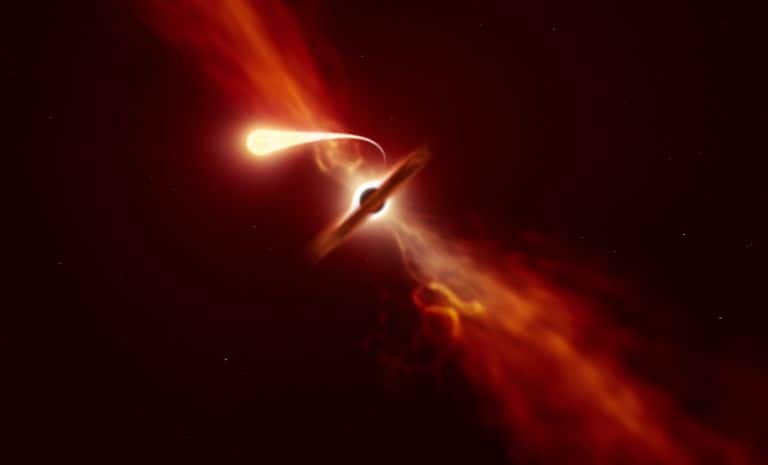Death by spaghettification, the rare burst of light emitted by a star when it is sucked in by a supermassive black hole has been spotted by scientists using telescopes from around the world.
Astronomers, in the course of observing the event of the tidal destruction of a star by a black hole, closest to Earth, confirmed the idea that the shell absorbing the radiation of a flare is created by outflows arising from the accretion of the stripped material of the star onto the black hole.
When a star is near a massive black hole, at a distance less than the tidal radius, it will be destroyed by tidal forces in a process called spaghettification, and some of the star’s material will be absorbed by the black hole, forming an accretion disk around it. In this case, the terrestrial observer will see bright flashes of radiation, the luminosity of which will be comparable to or higher than the Eddington limit, which astronomers refer to as tidal destruction events. Such phenomena are recorded several times a year, have various characteristics, and are extremely important for the correct construction of models for the accretion of matter onto black holes.
Astronomers led by Matt Nicholl of the University of Birmingham have published the results of observations of the AT2019qiz flash detected in September 2019 using the automatic systems ZTF (Zwicky Transient Facility), ATLAS and PanSTARRS. Spectroscopic studies at the Keck Observatory helped to confirm that a flare is an event of tidal destruction of a star by a black hole. It occurred in the bright spiral galaxy 2MASX J04463790-1013349, located at a distance of about 215 million light-years from the Sun in the constellation Eridani, and was observed by the VLT (Very Large Telescope) and NTT (New Technology Telescope) telescopes, the ATCA radio telescope system ( Australia Telescope Compact Array) and other observatories, which made it possible to cover four wavelength ranges: ultraviolet, optical, X-ray and radio-range.
Scientists recognized the flare as the closest phenomenon of this kind to Earth and the first event of tidal destruction at z <0.02, detected in the radio range. Analysis of the data showed that the mass of the black hole was about one million times the mass of the Sun, and the initial mass of a star, which happened to be near it, is comparable to the mass of our star. On approaching, three-quarters of the star’s mass was blown away by the black hole, creating a stream of matter accreting onto the black hole. At the same time, outflows of matter arose in the vicinity of the black hole, moving at a speed of up to ten thousand kilometers per second, which created a radiation-absorbing screen for the terrestrial observer.
Thus, AT2019qiz provides the most significant evidence that the material outflow is responsible for the theoretically predicted optically thick Eddington shell and explains the low X-ray luminosity of most observed optical events of tidal destruction.
The preprint of the work is published on the websitearXiv.org, briefly described on the website of the European Southern Observatory.
